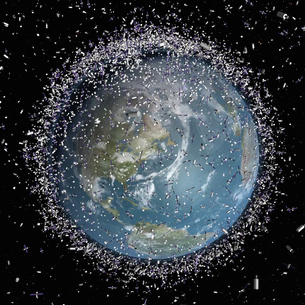Game theoretic analysis of the space debris removal dilemma
This project was a partnership with the Advanced Concepts Team of the European Space Agency under the Ariadna framework.
The study aimed to analyse space debris removal efforts from a strategic, game-theoretical perspective. The objective was three-fold, one, to model debris accumulation and active removal efforts as a dynamic game, two, to determine the optimal time-dependent policies or behaviour assuming both cooperative and self-interested players, and three, to propose a mechanism to steer the dynamics of the game to a desirable outcome. It was expected that such a study would provide a deeper understanding of the space debris problem and its potential (economic) ramifications, and an outlook on potential game-theoretic solution strategies.
Background

Space debris is defined as non-manoeuvrable, human-made objects orbiting Earth. Space debris poses a significant collision risk for an operational spacecraft, especially in low-Earth orbit (LEO). At typical relative velocities of 10km/s, a collision with a piece of space debris of about 10cm in diameter is expected to cause a disintegration of the spacecraft. This breakup causes a large number of fragments and the higher density of debris increases the risk of collision further. The build-up of space debris eventually results in a catastrophic cascade of collisions, also called the Kessler syndrome. Currently, there are more than 23,000 objects larger than 5-10cm in Earth orbit (see figure).
Within the Clean Space initiative ESA is investigating active debris removal in addition to mitigation measures to keep the growth of space debris limited. In cooperation with the national space agencies and industry partners, ESA is developing mission concepts to clean up and deorbit space debris. In addition to a number of complex technical challenges, active debris removal is a very costly undertaking.
Due to the risk of a collision cascading, measures taken early on are desirable. As space agencies, as well as commercial players, have an interest to launch more and more satellites over the next decades, the necessity for active removal is growing and at some point will be imminent to secure operational safety for current and future missions. An active debris removal mission will have a positive effect (or risk reduction) for all satellites in the same orbital band. This leads to a dilemma: every player has an incentive to delay its actions and wait for others to respond. Each player is faced with the decision between acting now or postponing to take action, i.e., either take an individually costly action of debris removal, which has a positive impact on all players; or wait until others jump in and do the ‘dirty’ work, as this will be at their own benefit and reduce their own costs. The risk of the latter action is that if everyone waits the joint outcome will be catastrophic leading to what in game theory is referred to as the ‘tragedy of the commons’.
People
The following researchers were involved in this project:
Prof. Karl Tuyls (UoL)
Dr. Rahul Savani (UoL)
Dr.
Daan Bloembergen (UoL)
Dr. Dario Izzo (ESA)
Dr. Daniel Hennes (ESA)
Richard Klima, M.Sc. (UoL)
The project concluded in 2016 – the final report is available from ESA.